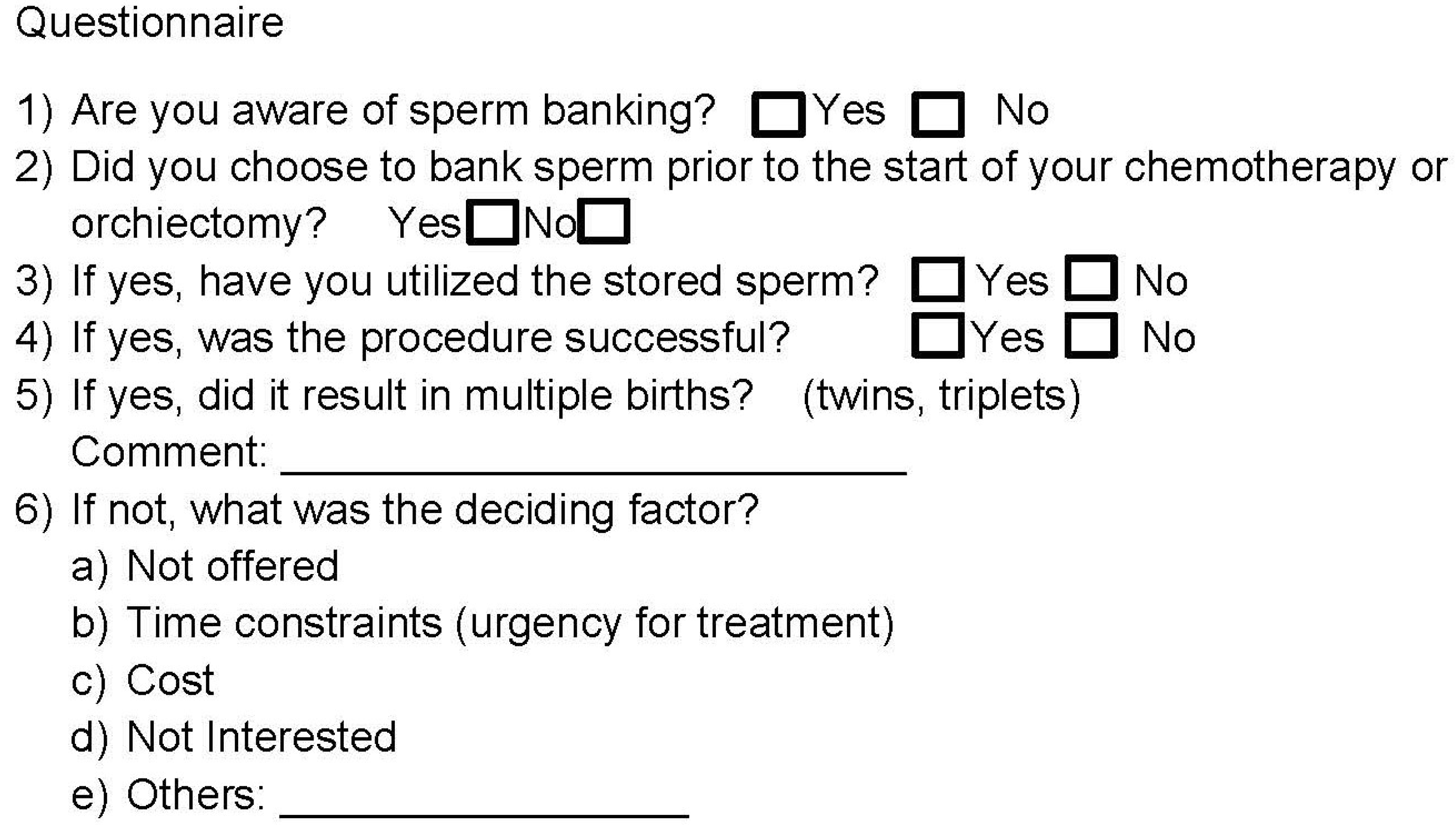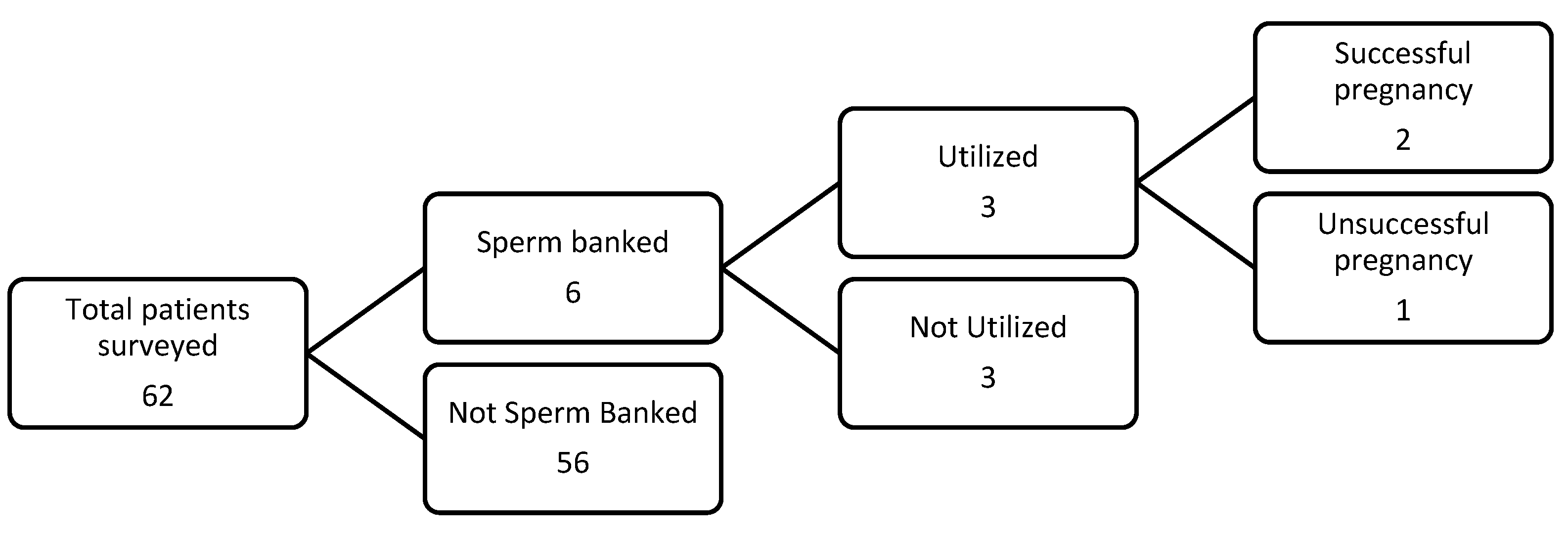A Survey of Attitude on Sperm Banking and Barriers to Its Use among Testicular Cancer Patients in a Multicultural Asian Population
Abstract
1. Introduction
Objectives of the Study
2. Materials and Methods
2.1. Study Design
2.2. Data Collection
2.3. Patient Eligibility Selection
- Aged 18 years or older at the time of survey;
- Diagnosis of testicular tumor treated with orchidectomy or chemotherapy;
- Cognitively able to complete a questionnaire to be included in the study.
2.4. Statistical Analysis
2.5. Privacy and Confidentiality
3. Results
3.1. Socio-Demographic Data of Study Samples
3.2. Sperm Banking Awareness among Testicular Cancer Patients
3.3. Sperm Banking Utilization and Barriers to Its Use
3.4. Examining Gestational Outcomes Following Sperm Banking
3.5. Identifying and Analyzing Factors Associated with Barriers to Sperm Banking
4. Discussion
Author Contributions
Funding
Institutional Review Board Statement
Informed Consent Statement
Data Availability Statement
Conflicts of Interest
References
- Sharlip, I.D.; Jarow, J.P.; Belker, A.M.; Lipshultz, L.I.; Sigman, M.; Thomas, A.J.; Schlegel, P.N.; Howards, S.S.; Nehra, A.; Damewood, M.D.; et al. Best practice policies for male infertility. J. Urol. 2002, 167, 2138–2144. [Google Scholar] [CrossRef]
- Petersen, P.M.; Skakkebaek, N.E.; Vistisen, K.; Rørth, M.; Giwercman, A. Semen quality and reproductive hormones before and after orchiectomy in men with testicular cancer. J. Clin. Oncol. 1999, 161, 822–826. [Google Scholar]
- GLOBOCAN. New Global Cancer Data. 2020. Available online: https://gco.iarc.who.int/media/globocan/factsheets/populations/458-malaysia-fact-sheet.pdf (accessed on 10 March 2024).
- Malaysia National Cancer Registry Report 2012–2016. Available online: https://www.moh.gov.my/moh/resources/Penerbitan/Laporan/Umum/2012-2016%20(MNCRR)/MNCR_2012-2016_FINAL_(PUBLISHED_2019).pdf (accessed on 10 March 2024).
- Rives, N.; Perdrix, A.; Hennebicq, S.; Saïas-Magnan, J.; Melin, M.-C.; Berthaut, I.; Barthélémy, C.; Daudin, M.; Szerman, E.; Bresson, J.-L.; et al. The semen quality of 1158 men with testicular cancer at the time of cryopreservation: Results of the French National CECOS Network. J. Androl. 2012, 33, 1394. [Google Scholar] [CrossRef] [PubMed]
- Brydøy, M.; Fosså, S.D.; Klepp, O.; Bremnes, R.M.; Wist, E.A.; Wentzel-Larsen, T.; Dahl, O.; for the Norwegian Urology Cancer Group III Study Group. Paternity and testicular function among testicular cancer survivors treated with two to four cycles of cisplatin-based chemotherapy. Eur. Urol. 2010, 58, 134. [Google Scholar] [CrossRef] [PubMed]
- Brydøy, M.; Fosså, S.D.; Klepp, O.; Bremnes, R.M.; Wist, E.A.; Bjøro, T.; Wentzel-Larsen, T.; Dahl, O.; Norwegian Urology Cancer Group (NUCG) III Study Group. Sperm counts and endocrinological markers of spermatogenesis in long-term survivors of testicular cancer. Br. J. Cancer 2012, 107, 1833. [Google Scholar] [CrossRef] [PubMed]
- Talib, J.; Mamat, M.; Ibrahim, M.; Mohamad, Z. Analysis on Sex Education in Schools Across Malaysia. Procedia-Soc. Behav. Sci. 2012, 59, 340–348. [Google Scholar] [CrossRef][Green Version]
- Yusof, T.A. Malaysia’s First Oncofertility Centre Gives Hope for Cancer Patients. News Straits Times, Kuala Lumpur. 2020. Available online: https://www.nst.com.my/news/nation/2020/08/619677/malaysias-first-oncofertility-centre-gives-hope-cancer-patients (accessed on 10 March 2024).
- Pusat Reproduktif Termaju HCTM. Available online: https://hctm.ukm.my/mac/ (accessed on 10 March 2024).
- Department Of Statistics Malaysia Official Portal. Available online: https://v1.dosm.gov.my/v1/index.php (accessed on 10 March 2024).
- Logan, S.; Perz, J.; Ussher, J.; Peate, M.; Anazodo, A. Systematic review of fertility-related psychological distress in cancer patients: Informing on an improved model of care. Psycho Oncol. 2019, 28, 22–30. [Google Scholar] [CrossRef] [PubMed]
- Gilbert, K.; Nangia, A.K.; Dupree, J.M.; Smith, J.F.; Mehta, A. Fertility preservation for men with testicular cancer: Is sperm cryopreservation cost effective in the era of assisted reproductive technology? Urol. Oncol. 2018, 36, 92.e1–92.e9. [Google Scholar] [CrossRef] [PubMed]
- Sonnenburg, D.W.; Brames, M.J.; Case-Eads, S.; Einhorn, L.H. Utilization of sperm banking and barriers to its use in testicular cancer patients. Support Care Cancer 2015, 23, 2763–2768. [Google Scholar] [CrossRef] [PubMed]
- Moody, J.A.; Ahmed, K.; Yap, T.; Minhas, S.; Shabbir, M. Fertility managment in testicular cancer: The need to establish a standardized and evidence-based patient-centric pathway. BJU Int. 2019, 123, 160–172. [Google Scholar] [CrossRef] [PubMed]
- Schover, L.R.; Brey, K.; Lichtin, A.; Lipshultz, L.I.; Jeha, S. Oncologists’ attitudes and practices regarding banking sperm before cancer treatment. J. Clin. Oncol. 2002, 20, 1890–1897. [Google Scholar] [CrossRef] [PubMed]
- Employees Provident Fund Offical Website. Raja Permaisuri Agong Graces the Launch of EPF’s Health Withdrawal for Fertility Treatment. 2020. Available online: https://www.kwsp.gov.my/w/raja-permaisuri-agong-graces-the-launch-of-epf-s-health-withdrawal-for-fertility-treatment (accessed on 10 March 2024).
- Ahmad, M.F.; Ghani, N.A.R.N.A.; Abu, M.A.; Karim, A.K.A.; Shafiee, M.N. Oncofertility in Islam: The Malaysian Perspective. Front. Reprod. Health 2021, 3, 694990. [Google Scholar] [CrossRef] [PubMed]


| Variables | N (%) |
|---|---|
| Number of Patients | 62 (100) |
| Age at Diagnosis, Median (Range) | 31.5 (21–67) |
| Ethnicity, n (%) | |
| Malay | 38 (61.3) |
| Chinese | 16 (25.8) |
| Indian | 1 (1.6) |
| Borneos | 7 (11.3) |
| Religion | |
| Islam | 39 (62.9) |
| Buddhist | 10 (16.1) |
| Christian | 13 (21.0) |
| Educational Level | |
| Primary | 7 (11.3) |
| Secondary | 22 (35.5) |
| Diploma | 17 (27.4) |
| Degree and above | 16 (25.8) |
| Household Income | |
| <RM2000 | 19 (30.6) |
| RM2000–RM4000 | 30 (48.4) |
| >RM4000 | 13 (21.0) |
| Marital Status | |
| Single | 26 (41.9) |
| Married | 36 (58.1) |
| Sperm Banking | Odds Ratio (95% Confidence Interval) | p Value | ||
|---|---|---|---|---|
| Yes | No | |||
| Number of patients | 6 (9.7) | 56 (90.3) | NA | |
| Age at Diagnosis, Median (Range) | 29 (22–34) | 32 (21–67) | NA | 0.172 (a) |
| Ethnicity, n (%) | ||||
| Malay | 1 (2.6) | 37 (97.4) | 1 (Ref) | 0.046 (b) |
| Chinese | 3 (18.8) | 13 (81.3) | 0.12 (0.11–1.23) | |
| Indian | 0 (0) | 1 (100) | NA | |
| Borneos | 2 (28.6) | 5 (71.4) | 0.07 (0.01–0.88) | |
| Religion | ||||
| Islam | 1 (2.6) | 38 (97.4) | 1 (Ref) | 0.026 (b) |
| Buddhist | 2 (20) | 8 (80) | 0.11 (0.01–1.31) | |
| Christian | 3 (23.1) | 10 (76.9) | 0.09 (0.01–0.93) | |
| Educational Level | ||||
| Primary | 0 (0) | 7 (100) | NA | 0.087 (b) |
| Secondary | 0 (0) | 22 (100) | NA | |
| Diploma | 3 (17.6) | 14 (82.4) | 1 (Ref) | |
| Degree and above | 3 (18.8) | 13 (81.3) | 0.93 (0.16–5.45) | |
| Household Income | ||||
| <RM2000 | 0 (0) | 19 (100) | NA | 0.061 (b) |
| RM2000–RM4000 | 3 (10.0) | 27 (90.0) | 1 (Ref) | |
| >RM4000 | 3 (23.1) | 10 (76.9) | 0.37 (0.06–2.15) | |
| Marital Status | ||||
| Single | 3 (11.5) | 23 (88.5) | 1 (Ref) | 0.689 (b) |
| Married | 3 (8.3) | 33 (91.7) | 1.43 (0.27–7.75) | |
| Have Children at Time of Diagnosis | ||||
| Yes | 1 (4.8) | 20 (95.2) | 1 (Ref) | 0.654 (b) |
| No | 5 (12.2) | 36 (87.8) | 0.36 (0.04–3.30) | |
Disclaimer/Publisher’s Note: The statements, opinions and data contained in all publications are solely those of the individual author(s) and contributor(s) and not of MDPI and/or the editor(s). MDPI and/or the editor(s) disclaim responsibility for any injury to people or property resulting from any ideas, methods, instructions or products referred to in the content. |
© 2024 by the authors. Licensee MDPI, Basel, Switzerland. This article is an open access article distributed under the terms and conditions of the Creative Commons Attribution (CC BY) license (https://creativecommons.org/licenses/by/4.0/).
Share and Cite
Tan, J.R.; Goh, Y.K.; Lei, C.M.; Shamsudin, N.M.; Omar, S.; Lim, M.S.; Teh, G.C. A Survey of Attitude on Sperm Banking and Barriers to Its Use among Testicular Cancer Patients in a Multicultural Asian Population. Soc. Int. Urol. J. 2024, 5, 247-255. https://doi.org/10.3390/siuj5040039
Tan JR, Goh YK, Lei CM, Shamsudin NM, Omar S, Lim MS, Teh GC. A Survey of Attitude on Sperm Banking and Barriers to Its Use among Testicular Cancer Patients in a Multicultural Asian Population. Société Internationale d’Urologie Journal. 2024; 5(4):247-255. https://doi.org/10.3390/siuj5040039
Chicago/Turabian StyleTan, Jin Rong, Yue Keng Goh, Chang Moh Lei, Nurul Murni Shamsudin, Shamsuddin Omar, Meng Shi Lim, and Guan Chou Teh. 2024. "A Survey of Attitude on Sperm Banking and Barriers to Its Use among Testicular Cancer Patients in a Multicultural Asian Population" Société Internationale d’Urologie Journal 5, no. 4: 247-255. https://doi.org/10.3390/siuj5040039
APA StyleTan, J. R., Goh, Y. K., Lei, C. M., Shamsudin, N. M., Omar, S., Lim, M. S., & Teh, G. C. (2024). A Survey of Attitude on Sperm Banking and Barriers to Its Use among Testicular Cancer Patients in a Multicultural Asian Population. Société Internationale d’Urologie Journal, 5(4), 247-255. https://doi.org/10.3390/siuj5040039





